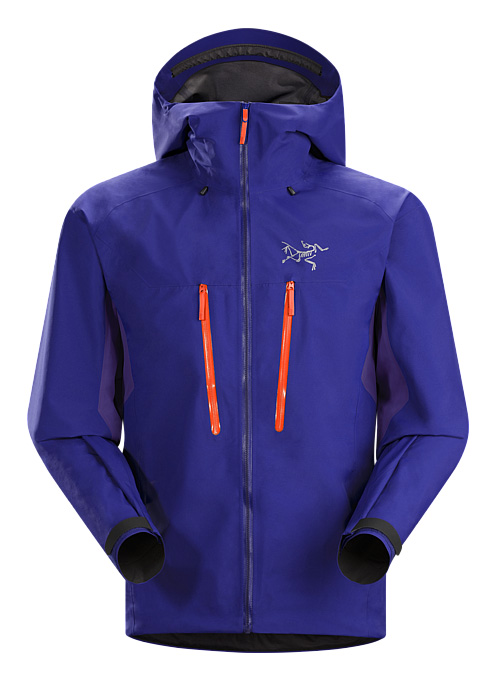
Quick overview:
- Usual full price: about $399.00 USD
- Weight: 405 g
- Pros: Fit, Simplicity, Function, Breathable, Weight
- Cons: Longer sleeves
- Suitability: For ski mountaineering in snowy or wet conditions
Bottom line:
A well designed jacket for ski mountaineering in snowy to wet conditions. That mostly means to break trail to chase fresh lines while the storm is still dumping 🙂
Photos:
Product description and How we tested it:
I was very curious to see how this Arc’teryx “hybrid” jacket would perform because I seldom skin up in waterproof clothing due to limited breathability and “heat trapping”. Unless it’s snowing heavily, the best setup I figured out over the years is to climb wearing one or two thin base layers under a super thin and breathable windbreaker. Then at the top, depending on temperature, I throw on a puffy or a Gore jacket. With the Procline Comp jacket I was ready to test something new.
According to Arc’teryx website, the Procline Comp uses “N40p 3L Gore Fabric Technology with tricot in the hood, shoulders, around the hemline and on the front of the body” to provide protection from snow, moisture and wind where most needed. The back and under the arms panels, the sweating spots, feature stretchy “Fortius 1.0 softshell … for freedom while climbing and a level of air permeability that permits heat and moisture vapour escape”.
In the past two months, the Coast Mountains here in south British Columbia saw couple of storm cycles pass through. They are famous for their massive dumps, mostly occurring just below or around freezing temps, which makes conditions calling for a shell that would ideally be 100% waterproof yet 100% breathable. The Procline jacket gives it a great shot.
The first thing I noticed wearing it was how well it fit, leaving only just enough room for a light puffy. I am 6′ 2″ with wide shoulders but got it in medium size as I am skinny otherwise. The jacket is sewn together from about 15 panels which helps a lot to achieve the athletic fit. The only thing I haven’t get used to yet are the long-ish sleeves. I feel like the extra length makes them “curl up” a bit around the elbows.
Materials used and minimalist design also make this jacket incredibly light. I am not too obsessed with my ski touring clothing weight but saving 300-500 grams with a jacket means that you can either a carry a bigger lunch or just simply enjoy the lightness you are wearing.
I used the jacket on couple of occasions now and overall I found it to perform as I expected – much better than my older Gore jackets on the up but with the same protection on the way down. On one specific occasion, while skinning up in moist, snowy weather and breaking trail up a steep forest there was no way avoiding to brush against snow covered tree branches. I spent most of the 3h of ascending wearing the hood, and zipping and unzipping the front to add ventilation as needed. Underneath, I only wore one thin base layer and didn’t get too hot or cold while the temps range about between -1 C to -6 C during the whole day. With couple of days like that, I can honestly say that the jacket breaths better then any other hard shell I ever had, however, don’t expect to fully break trail fully zipped up and not to sweat inside. That’s still to be invented 😉
The Procline Comp jacket has no inside skin pockets so you will either have to put your skins in your pack or use the two outside chest pockets. I am not sure whether those were designed to carry skins but if yes then they are not big enough for the widest/longest skins. Since I mostly put skins in my pack when touring (and the pockets easily accommodate race skins) I used the chest pockets to keep my extra buff, a hat, or a phone dry. They are placed at the right spots and don’t get covered by backpacks waist strap at all, and should be just below the chest strap for most as well.
The hood was designed to accommodate a ski mountaineering or a climbing helmet. It works well, although, I seldom wear a helmet on powder/stormy days. However, the hood works well even without a helmet thanks to the well thought out design and adjustment cords.
To finish, what I really like about this jacket is how the bottom is cut in a curve to gradually drop on the sides, making the back longer, thus, prevent my butt from getting wet. On the other hand, the front bottom is high enough to not curl up when I have to lift my thighs high when setting a steeper track.
Pros:
- Works very well for conditions it was designed for
- Fits great and weighs nothing
- Very minimalist/stripped down design
Cons / What can be improved about this product:
- I would propose that Arc’teryx cuts the sleeve length by about 1 inch, that would work for me.
- If the chest pockets (not the zippers) were slightly deeper or wider then they can work more comfortably as skin pockets even for big skins (110+ mm, or split board).
Product Specs:
- Materials: N40p 3L GORE® Fabric Technology, Fortius 1.0 softshell
- Sizing: XS, S, M, L, XL, XXL

